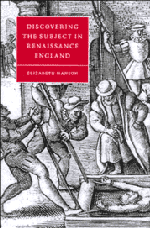1 - Introduction
Published online by Cambridge University Press: 21 October 2009
Summary
When Hamlet rails that Guildenstern, formerly a school friend, now a spy recruited by the king, “would pluck out the heart of my mystery” (3.2.356–7), he assumes a position, as the resistant object of another man's scrutiny, within a scenario that recurs insistently in the discourses of Renaissance England. The struggle to discover the secrets in another's heart, or to resist being the object of such discovery, is rehearsed not only in the drama but in the records of the Privy Council and state trials, and in correspondence, philosophical writing, conduct books, and literature of social description of the period. In fact, Hamlet's imagery here links his situation both to the actual culmination of many discovering operations of the Elizabethan state, the extraction and display of the traitor's heart at execution, and to moments of resistance to such operations, as when Catholic sympathizers wrote of the martyred Jesuit Edmund Campion that “one might sooner pluck his heart out of his bosom than rack a word out of his mouth that he made conscience of uttering.” The hostile discovery of another's innermost being, with its concomitant insistence on that other's secrecy, constitutes one of the most prevalent and historically specific versions of inter-subjectivity in Renaissance England. These discovering operations differ from other practices which make the heart the object of knowledge, such as the spiritual accounting of seventeenth-century Puritanism or the much later explorations of psychoanalysis, both in the presumed enmity of the participants and in the reification of the “mystery” of inner life they entail, the reduction which makes the “heart” susceptible to “plucking.”
- Type
- Chapter
- Information
- Discovering the Subject in Renaissance England , pp. 1 - 23Publisher: Cambridge University PressPrint publication year: 1998

